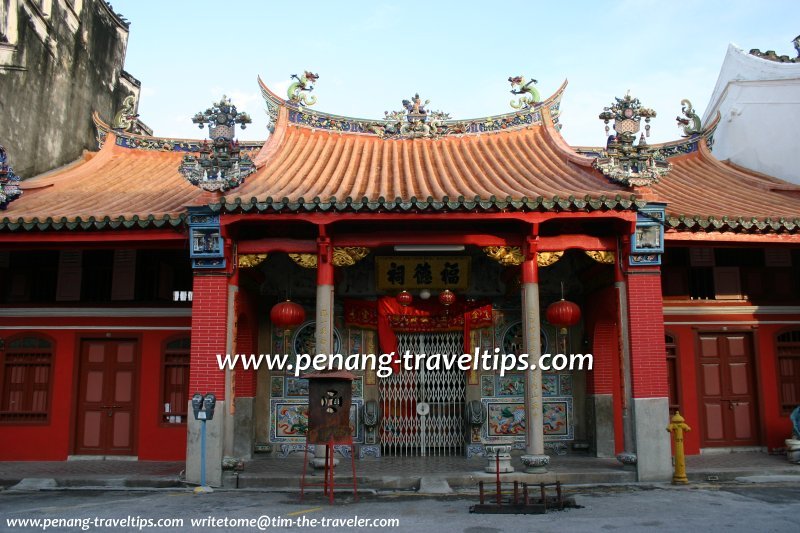 The Cantonese Tua Pek Kong Temple, George Town (20 March 2004)
The Cantonese Tua Pek Kong Temple, George Town (20 March 2004)
Cantonese Tua Pek Kong Temple (GPS: 5.41841, 100.34007), also called Thai Pak Koong Temple, is a Taoist temple withing the George Town UNESCO World Heritage Site. It won the 2021 UNESCO Asia Pacific Awards for Cultural Heritage Conservation.
The Cantonese Tua Pek Kong Temple is located at 32, 32A & 34 King Street, sandwiched between the Heong San Hoay Kuan and the Nin Yong Temple, is what gives King Street its Chinese name, Kuin-Tang Tua Pek Kong Kay, meaning Cantonese Tua Pek Kong Temple Street.
Built in 1810, it is believed to be the second oldest Chinese temple in George Town (after the Kuan Im Teng Temple).
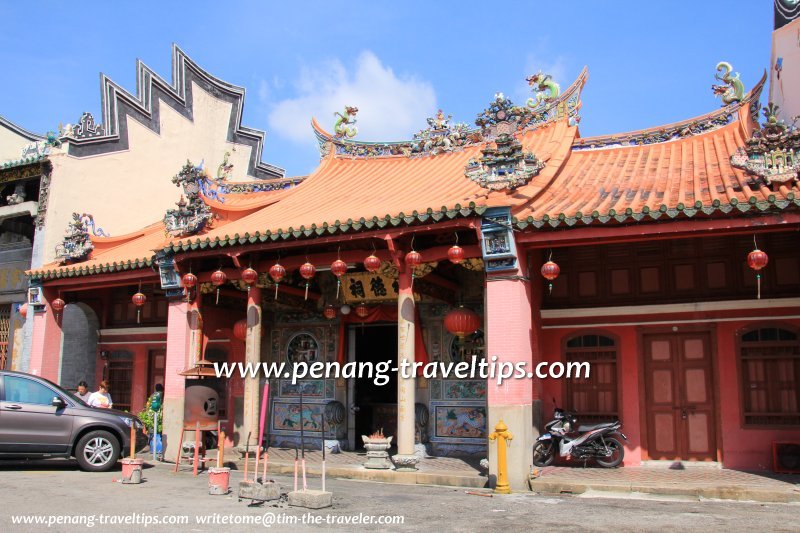 Cantonese Tua Pek Kong Temple, King Street, George Town (15 September 2012)
Cantonese Tua Pek Kong Temple, King Street, George Town (15 September 2012)
Tua Pek Kong, in the Penang context, is a deified personification of Tudigong. He is said to be a person of Hakka descent by the name of Zhang Li. Zhang Li arrived in the Malay peninsula in the mid 18th century. Enroute to Sumatra, his boat was caught in a storm that brought him to Penang. He landed there in the mid 18th century, a good 40 years before Francis Light founded the British settlement at George Town.
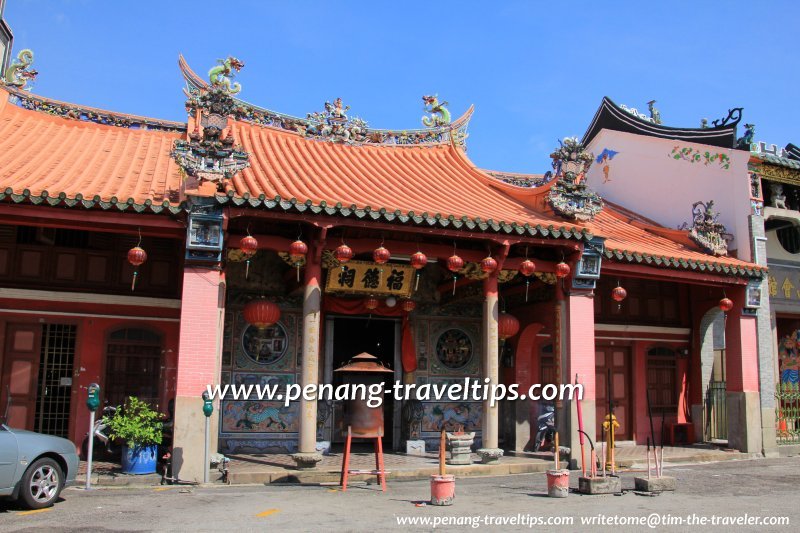 Another view of the Cantonese Tua Pek Kong Temple (15 September 2012)
Another view of the Cantonese Tua Pek Kong Temple (15 September 2012)
Fifty years after the death of Zhang Li, the local Chinese in the Malay peninsula began the worship of him as Tua Pek Kong, meaning Great Grand Uncle, the god of prosperity. The Chinese believe that the worship of Tua Pek Kong help them in accumulating wealth and this ensures that shrines to Tua Pek Kong were constructed throughout West Malaysia, Singapore and East Malaysia. These shrines today become the Tua Pek Kong Temples. Accumulating wealth is a jealously guarded community endeavor. Hence the Hokkien and the Hakkas were split in their worship of this deity.
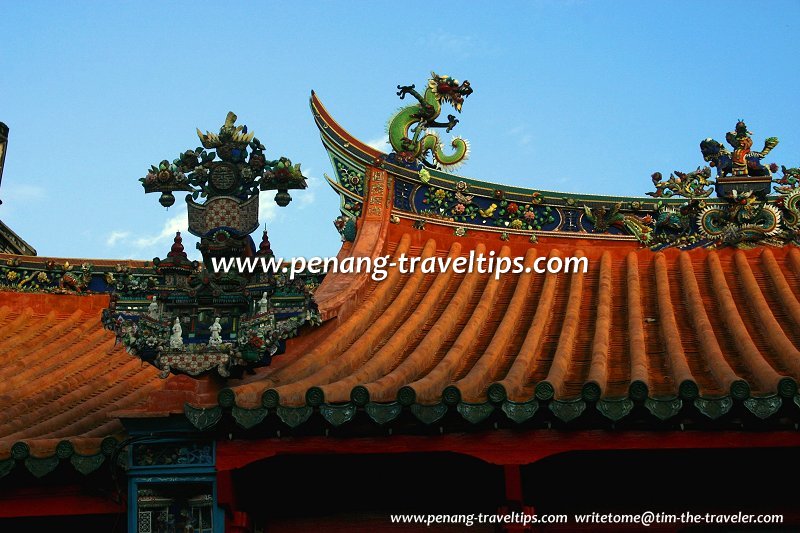 Roof features of the Cantonese Tua Pek Kong Temple (20 March 2004)
Roof features of the Cantonese Tua Pek Kong Temple (20 March 2004)
The Tua Pek Kong Temple of King Street is run by the Cantonese and Hakka community, while the Hokkiens have their own Tua Pek Kong Temple at the Hock Teik Cheng Sin in Armenian Street. In the olden days, both the Cantonese and the Hokkiens held annual processions to the Tanjong Tokong Tua Pek Kong Temple, regarded as the mother temple of all Tua Pek Kong temples in the region.
The Cantonese Tua Pek Kong Temple of King Street was built by the Hakka and Cantonese communities to ensure that the communities have a place to worship the god of prosperity. The building was constructed somewhere in the middle of the 18th century, with renovations done around 1909. Rather than conforming to the Cantonese style of temple architecture, as seen in the adjacent Nin Yong Temple next door, the Cantonese Tua Pek Kong Temple follows a Hokkien style temple architecture.
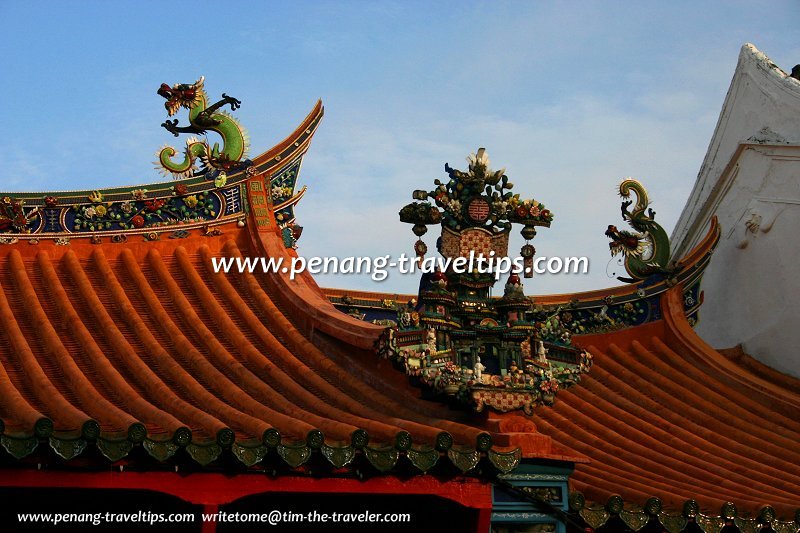 Chien Nien ornamentation of the Cantonese Tua Pek Kong Temple (20 March 2004)
Chien Nien ornamentation of the Cantonese Tua Pek Kong Temple (20 March 2004)
What to see
Admire the roof ornamentation and sloping roof rafters. Chien Nien broken pottery ornamentation is used in the roof decoration, which sees dragons and tiny figurines. The red facade, divided into three bays, with ornate windows in the middle bay, is particularly attractive. On either side of the temple are side bays with act as living quarters, with decidedly simpler design.How to get there
Using Weld Quay Ferry & Bus Terminal as a point of reference, cross Pengkalan Weld and then turn right. Walk along Pengkalan Weld until you reach Gat Lebuh Gereja. Turn left. Walk along Gat Lebuh Gereja, past the Beach Street junction, onwards through Lebuh Gereja, until you reach Lebuh King. Turn left and you will find the Cantonese Tua Pek Kong Temple on the right side of the road, after the Heong San Hoay Kuan.Cantonese Tua Pek Kong Temple is  on the Map of Lebuh King, Penang
on the Map of Lebuh King, Penang
List of Tua Pek Kong Temples in Penang, Chinese Temples in Penang and Chinese Temples in Malaysia

Copyright © 2003-2025 Timothy Tye. All Rights Reserved.

 Go Back
Go Back